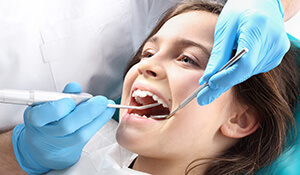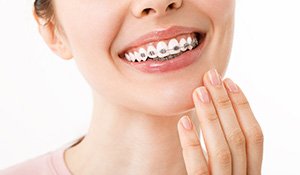Regular Orthodontics in Richardson
 Even if we’re able to provide early orthodontic intervention, we’ll likely encourage patients to go on with regular orthodontic care beginning around the age of 12. This is typically when all baby teeth are lost and adult teeth have erupted from the gum line. We may recommend braces or Invisalign depending on your needs, but the goal of regular orthodontic care is simple. We want to improve the look, feel, and function of the smile, so patients are able to maintain their optimal level of oral health for a lifetime.
Even if we’re able to provide early orthodontic intervention, we’ll likely encourage patients to go on with regular orthodontic care beginning around the age of 12. This is typically when all baby teeth are lost and adult teeth have erupted from the gum line. We may recommend braces or Invisalign depending on your needs, but the goal of regular orthodontic care is simple. We want to improve the look, feel, and function of the smile, so patients are able to maintain their optimal level of oral health for a lifetime.
Indications for Orthodontic Treatment
There are a number of indicators you may notice or a regular checkup may uncover that indicate a need for orthodontic intervention. If you notice any combination of the follow symptoms, we encourage you to talk to your general dentist to determine whether or not you may benefit from orthodontic treatment:
- Discomfort or difficulty when chewing
- Chronic mouth breathing
- For younger patients, thumb or finger sucking
- Crowding, wide gaps between teeth, or otherwise uneven spacing
- Teeth that do not erupt
- Teeth that erupt in an inappropriate position
- Teeth that do not develop
- Jaw that is improperly positioned or that shifts out of alignment when you bite
- Biting into soft tissue when chewing
- Over, under, or crossbite
- Teeth that don’t close together, sometimes called an open or deep bite
- Lips that do not close over teeth
Braces Step by Step
 Initial Consultation
Initial Consultation
We’ll start with a careful evaluation including digital Ceph x-rays and panoramic scans, so we have a complete understanding of your smile, how the bite fits together, and what orthodontic care you may need. We’ll be happy to answer any questions you may have, explain your treatment options, and partner with you to create a personalized plan for ongoing oral health care. Before the end of your visit, we’ll review your treatment options, provide estimates for the duration of treatment and costs of care, and work with you to determine what orthodontic treatment will most benefit your smile.
 Initial Bonding Appointment
Initial Bonding Appointment
As soon as we can following your initial consultation, we’ll schedule your first treatment appointment. The first treatment is the attachment of your brackets and spacers. The brackets are the pieces bonded to the front of the tooth that allow bands and wires to place pressure on teeth causing them to move. Spacers make room for bands. If your bracket or spacer comes out prior to your banding appointment, please call us right away, so we can reattach these. You’ll also need to provide a letter from your general dentist that verifies you are free from decay, gum disease, or other oral health concerns. The appointment itself typically takes a little over an hour.
 Banding
Banding
Prior to the banding appointment, you may need to have one or more teeth removed. This is necessary if you are experiencing crowding or have other significant concerns with the eruption of teeth. We will not be able to attach your bands and wires until after this is completed. About two weeks after your bonding appointment, you’ll visit us for banding. We’ll remove spacers and attach bands and wires, adjusting them as necessary to place pressure on teeth to move them into position.
 Adjustments
Adjustments
Every four to six weeks, you’ll come back to our office, so we can adjust your bands and wires. These visits will continue at regular intervals until the end of your treatment. You should plan for each of your adjustments to take about half an hour.
 Debanding Visit
Debanding Visit
We will remove all brackets and wires at this appointment and supply your retainer. This treatment takes about an hour.
 Final Appointment
Final Appointment
About a month after the debanding visit, you’ll return for your final appointment. We’ll capture photos and x-rays to ensure you’ve achieved the desired results. We will also check the fit and comfort of your retainer. Plan to be in our office for about half an hour.
Understanding the Cost of Traditional Braces

The cost of traditional braces can vary depending on a number of different factors. When you visit us for a consultation, our on-staff orthodontist will evaluate the details of your case before we can provide a detailed cost estimate. Generally speaking, traditional braces are one of the most affordable ways to correct dental misalignment.
Factors That Affect the Cost of Traditional Braces

Some factors that may affect the cost of your braces include:
- The severity of your dental misalignment. This is the largest influence on the cost of braces. It affects how many appointments you need, the overall length of your treatment, and whether you require any special accessories. Naturally, all such factors can affect overall price.
- Your age. Often, the teeth of younger people move faster than those of mature adults. Therefore, there can be a price difference.
- Compliance with treatment guidelines. Mishaps during your treatment might affect costs. For example, if you do not wear rubber bands as instructed, that could slow down your treatment and potentially lead to higher fees.
Professional Braces vs. “DIY” Braces: Which Costs More?

You might have heard of so-called “hacks” that some individuals have used to straighten their teeth instead of professional braces. These methods might seem appealing because they tend to be inexpensive, often utilizing common objects like fishing line, earring backs, rubber bands, and superglue.
Before you try any of these ideas, it is important to acknowledge the fact that if you do not have professional training, you could easily end up worsening the alignment of your teeth. Some people have even caused serious damage to their smile. Often, it is more affordable to get professional treatment right from the beginning of your teeth-straightening endeavors.
Does Dental Insurance Cover Braces?

Here are some important notes to keep in mind about dental insurance and traditional braces:
- Some premium plans cover up to 50% of the cost of braces (up to a designated lifetime orthodontic maximum).
- Coverage for minors is more common than coverage for adults.
- Some specialty orthodontic treatments may not be covered at all.
Our Richardson practice welcomes insurance, and we will be happy to help you figure out how your benefits may apply to your treatment plan.
Options for Making Braces Affordable

Beyond insurance, there is another provision that might make it easier for you to afford your braces: financing. We work with CareCredit, a third-party lender, to provide low-interest and no-interest payment plans for our patients. The application process is fast, and the majority of people are deemed eligible for credit. You may be able to choose a monthly payment amount that fits your family’s budget.
Are you interested in learning more about traditional braces and their cost? Get in touch with EPO Dental Specialists today; our friendly team will be happy to answer your questions!
Traditional Braces FAQs
Do Traditional Braces Hurt?
Of course, one of the most-asked questions about braces is: do they hurt? If you’ve been wondering about this yourself, then you’ll be happy to hear that advancements in the field of orthodontics have made traditional braces considerably more comfortable. That said, some soreness is to be expected as your teeth move into their properly aligned positions. The best way to combat any discomfort or pressure you feel is by using dental wax to cover the sharp edges of your brackets and wires, taking OTC pain medication as directed, and eating soft foods, like oatmeal.
Am I Too Old to Get Braces?
There’s a common misconception that if you didn’t get braces as a teenager or young adult, the ship has sailed. That’s not the case. In fact, there isn’t an upper age limit for braces! Candidacy is instead determined by factors like the state of the patient’s oral health and how severe their case of malocclusion is. So, don’t let your age stop you from scheduling an appointment.
What Can You Not Eat with Traditional Braces?
To prevent a bracket from coming loose or a wire from moving out of position, patients with traditional braces are instructed to avoid all crunchy foods, including tortilla chips, whole apples, thin pizza crust, and hard pretzels. Fortunately, mashed potatoes, yogurt, cooked pasta, and plenty of other delicious foods can still be enjoyed throughout the teeth-straightening process. So, you don’t have to worry – you can still enjoy a varied, satisfying, and well-balanced diet with traditional braces!
What Happens After You Get Your Braces Off?
After we’ve moved your teeth and bite into proper alignment, it’s time for the retention phase. At this point, our goal is to preserve your results. We do this with a retainer, which is a custom-made orthodontic appliance that you will wear each evening while you sleep (unless instructed otherwise). This is a crucial step of the treatment process because, if you don’t wear your retainer, your chances of experiencing orthodontic relapse skyrocket.
Can I Get Traditional Braces on Just My Top or Bottom Teeth?
Since straightening one row of teeth and not the other can negatively impact a patient’s bite, single-arch treatment is rare. That said, there are some cases where it is possible. So, don’t hesitate to ask if that’s an option for you at your consultation!
Can You Drink Coffee with Traditional Braces?
Yes, you can! Just keep in mind that your teeth are susceptible to staining. That’s why we strongly recommend using a straw, keeping sugar and other additives to a minimum, and drinking plenty of water. When you’re done enjoying your coffee, rinse your mouth thoroughly with clean water and then brush your teeth about 20 minutes later.
Can I Chew Gum with Traditional Braces?
It’s certainly not recommended. Sticky substances like chewing gum can get caught in your braces, which could bend the wires and cause your teeth to shift in unexpected directions. This can happen whether you notice or not and can add time to the length of your treatment.
While some research does suggest that chewing gum can relieve some of the initial discomfort you may experience when you first get braces or when you have them adjusted, and sugarless gum has other oral health benefits, they are generally not worth the trouble caused to your braces, and its better instead to stick to brushing and flossing to get the same results.
Can You Whiten Your Teeth While Wearing Braces?
It is recommended that you hold off on whitening your teeth while you’re wearing braces. That’s because bleaching solution can’t reach the areas of your teeth that are covered by your brackets or to areas that are shifting and overlapping. As a result, your results may come out uneven.
Using white strips or trays also won’t work when a large portion of the teeth are covered.
It is usually safe to use whitening toothpaste and mouthwash; however, they do not typically produce very dramatic results.
Ask your dentist for tips on how to keep your teeth white while wearing braces, as well as for some suggestions for brightening them once you get your braces off.
Why Do My Teeth Feel Loose with Braces?
It’s common to be a little concerned if your teeth feel loose while wearing braces, but there’s no need to worry. It’s perfectly normal, and actually a sign that your treatment is working!
To align your teeth, your dentist needs to target specific teeth along the arches and apply force to them via your wires and brackets. By doing this, they are essentially loosening the ligaments that hold your teeth in place, allowing your braces to adjust their positioning in the jawbone.
As they’re being repositioned, it’s normal to feel as though your teeth are loose or even “floating.” The good news is that this feeling will go away once your braces are removed. Once your jawbone has gotten adjusted to the new positions of your teeth, it will reabsorb and solidify them in place, and the feeling of looseness will fade.
Do Traditional Braces Cost More Than Invisalign?
In most cases the cost of traditional braces is comparable to the cost of Invisalign; however, many dental insurance plans will not cover Invisalign treatment but will cover traditional braces.
In most cases, traditional braces cost between $1,800 and $5,500, while Invisalign typically costs between $3,000 to $5,000. Of course, these are only average estimates.
Furthermore, with Invisalign there are certain caveats that aren’t a problem with traditional braces. For example, with Invisalign it’s possible to lose or damage your aligners, resulting in higher costs or upcharges. This isn’t an issue with traditional braces because they are secured to your teeth.
If you’re a candidate for both Invisalign and traditional braces, your orthodontist can help you compare the costs and the pros and cons of each to determine which option is best for you.
More to Explore
Endodontics Periodontal Care Orthodontics View All Our Services
